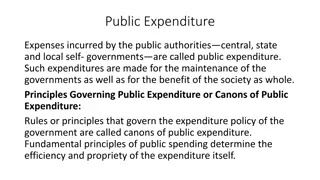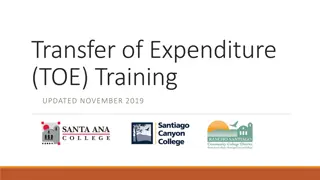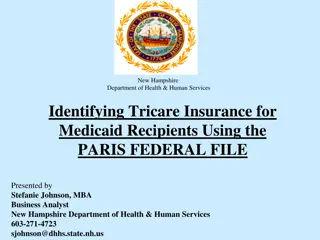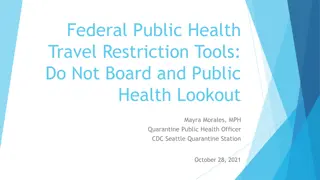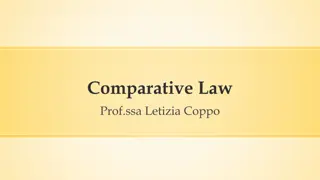History of Public Health Insurance in the US: Understanding Federal Expenditure Before 1900
Explore the historical development of public health insurance in the US, focusing on federal expenditure before 1900. Topics covered include Civil War implications, Freedmen's Bureau, pensions, mutual aid organizations, and early welfare states. The narrative delves into the Civil War era, internal improvements, and the impact of emancipation. Uncover key events such as the Confiscation Act and Emancipation Proclamation, shedding light on the evolution of public health initiatives pre-1900.
Download Presentation

Please find below an Image/Link to download the presentation.
The content on the website is provided AS IS for your information and personal use only. It may not be sold, licensed, or shared on other websites without obtaining consent from the author. Download presentation by click this link. If you encounter any issues during the download, it is possible that the publisher has removed the file from their server.
E N D
Presentation Transcript
HCMI 4225: History of Public Health Insurance in the US BUSN 203: Mon/Wed 9:30-10:45 Shane Murphy shane@uconn.edu
Contents Federal expenditure before 1900 Civil War Freedmen s Bureau Pensions Mutual Aid organizations Early Welfare States
Federal expenditure before the Civil War (1861-1865) Internal improvements, war, veterans pensions Defense (including pensions) made up about half of expenditure most years Congressional structure made federal spending particularly hard Before 1820, non-defense spending was largely government employee salaries Ways and means controlled budget; Finance committee (1816), Appropriations committee (1867) came later Increased Westward expansion and industrialization 1820s until 1920s were an era of appropriations
Internal improvements Building roads, canals, and railroads, river and harbor projects, and erecting lighthouses and other aids to navigation Henry Clay and John Quincy Adam s American System Seven Points of 1815 Era of internal improvements was 1825-1838 Opposed by President Andrew Jackson (1829- 1837) Ends with Panic of 1837 Land grants distribution of land sale revenues to states expanded greatly after 1841 Westward expansion and railroads Organization of Nebraska territory Slavery question Transcontinental railroad (1863-1869)
Civil war and emancipation Secession starts in 1860 after Lincoln elected, before inauguration, war begins April 12, 1861 First Confiscation Act (August 6, 1861) legalizes giving escaped slaves right to remain across Union lines called contraband Emancipation proclamation (September 22, 1862) Went into effect on January 1, 1863 Reconstruction Bureau of Refugees, Freedmen and Abandoned Lands (March 3, 1865)
Freedmens Bureau Impose a free labor system northern labor ideology onto the South Give labor rights to workers, largely black Less than 1000 agents, budget under $6 million per year Headed by Oliver O. Howard Opposed by President Johnson, financing stripped in 1869, fully closed in 1872 Black Codes (1865-1866) Federal troop occupation of the south continued until 1877 reconstruction era is 1865-1877 Set up schools, hospitals, banks, orphanages, old-age homes, distribute food and clothes By September 1867, ran 45 hospitals, with 5,292 beds, budget about $250,000 per year (budget supplemented by donations and by exchange with garrisons) Pressure to move fiscal responsibility to local officials led to closures of most hospitals in 1869.
Civil War pensions Competitive, patronage oriented political parties Republican coalition was complex and cut across class and region civil war pensions funded by precisely targeted tariffs could further electoral goals of the party Administered by the US Bureau of Pensions (merged into the VA in 1930) Pensions were advocated by the Grand Army of the Republic, a social group for veterans GAR became an important political group Disabled and elderly Veterans and their dependents were more generously aided than in fledgling welfare states of the day
Extending benefits beyond veterans Proposals to extend Civil War benefits used the language of "army of labor" to generalize from the Union Army Proposals had some limited support from trade unions Early 1900s proposals for old-age pensions, health and unemployment insurance, and labor regulations were rebuffed by the state Popular support for these early programs floundered due to negative reactions to being seen as unfounded charity Future programs would deal with this by becoming contributory Failures at the federal level led to state level attempts state level attempts had limited long-term success, but did develop ideas and expertise that would later be incorporated into the New Deal. Wisconsin - social insurance rather than tax financed welfare
Maternalist movement However, maternalist welfare state did begin to form In the early 1900s, women's organizations grew in strength, pushing for women's rights as well as increased social protection for women Both of these issues were cross-cutting, middle class women were aware of the possibility of destitution Maternalist social organization was advocated especially by groups such as: National Child Labor Committee, National Consumers League, the General Federation of Women's Clubs, the National Congress of Mothers, and the Daughters of the American Revolution.
Comparing maternalist and fraternal social organization Male dominated social groups cut across class and region But middle class female dominated groups formed with religious, charitable, and welfare purposes Task of shaping public opinion was key both in influencing legislatures to act and influencing courts to accept This was in contrast with courts striking down laws intended to shield unions, regulate working conditions, and regulate the market
Local medical systems Poorhouses/workhouses/pesthouses Urban public hospitals systems Funded by cities Staffing supplemented by medical students Limited willingness of counties and states to subsidize local systems before the Progressive Era (1890s-1916)
Childrens Bureau (1912) The Children's Bureau was a key federal program that resulted from this effort Key leaders were Lillian Ward (Nurse, worked at juvenile wards, mental health advocate, co-founder of NAACP), Jane Addams (First US female Peace Prize winner, cofounder of ACLU, city-level activist, Hull settlement house), Florence Kelley (labor advocate, cofounder NAACP, congressional advocate), and Julia Lothrop (social worker training, supported AALL push for greater public health insurance, Juvenile courts, first head of the Children's Bureau)
Key federal programs Children's Bureau: Birth registration Infant health campaigns commissioned studies Advocated for child labor protection - Keating Owen Act (1917-1918) Sheppard-Towner Act (1921-1929) New Deal Sheppard-Towner Act Midwife training programs, licensing, and enforcement Parent education through traveling health demonstrations, health centers, home visits, correspondence courses, and classes Establishment of standards and licensing procedures for maternity homes Data collection on maternal and infant mortality Lacked elite support: Keating Owen Act (1917-1918) - Killed by the Supreme Court Sheppard-Towner Act (1921-1929) - Sunsetted/failed to be renewed Opposed by AMA general congress supported by Pedriatic section
19thCentury US Life Insurance Life Insurance: Legal Reserve Insurance Stock companies Owned by Investors Mutual companies Owned by policy holders Fraternal orders
Legal Reserve Insurance Collects premiums in advance Establishes reserves and holds assets US regulation began in 1849 in New York State regulation of insurance
Mutual Aid and Fraternal Insurance Ancient Order of United Workmen (AOUW) formed in 1868 3 years after the end of the Civil War Fraternal insurers grew from beginnings in 1860s to controlling half the market in the 1890s Regulated after 1900 Generally required solvency Disappeared thereafter, shrinking to 8% of the market by 1930s
African American Insurance Societies Mutual Aid Societies also played multiple important roles in African American Society Insurance and social organization
Products of Fraternal Societies Life Insurance Sickness Insurance Accident Insurance Fixed-Fee Medical Care Provision Other Charity Social Organization
Causes of decline of Fraternal Insurance Regulation No regulation until 1888 Federal regulation began in 1893 Reserve requirement Self regulating Mobile Bill of 1910 Growth of group insurance Financial strain and dissolution Workers compensation laws and assistance
HCMI 4225: History of Insurance Online: Mon/Wed 9:30-10:45 Shane Murphy shane@uconn.edu
Otto van Bismarck Minister President of Prussia from 1862-1890 Oversaw Prussian Military victories from 1863-1871 Oversaw Prussian led unified Germany in 1871 Then appointed Imperial Chancellor, serving from 1871- 1890 First social insurance scheme in 1881, 1883, & 1884 Employer based: employers paying 2/3, employees 1/3 Responding to rising social movements and combat socialism
Why Germany? Germany saw greatest level of industrial growth in late 1800s German political philosophers (such as Fichte, Wagner, and Schaeffle) were less libertarian than Anglo counterparts (Smith, Mill, Franklin) Note that in many ways, Marx was more pro-state than French Socialists Well developed labor movement 1848 revolutions Goals: Democracy (anti-monarchy and pro working class), social justice, and, in the case of Germany, unification Bismarck worked with German Socialists from 1848 revolutions such as Ferdinand Lasalle
Initial forms First: Accident and sickness insurance Sickness in 1883, accident in 1884 Base on no-fault principle, industrial accidents a fact of life Later: Old age and invalidity Even later: Insurance for survivors of industrial accidents (widows and orphans) Maternity insurance (First program created in 1911 in Italy) Four Social Risks: injury, sickness, old age, and unemployment
Spread of accident insurance Social insurance programs were initially slow to spread, with only Germany, Austria, and Hungary having programs by 1894 But by 1904, most of Western, Central, and Northern Europe had programs United States was late, creating a program for federal employees only in 1908 Two years after the creation of a program in Mexico (then called Nuevo Leon) Canadian provinces largely created programs between 1908-1910 Sickness insurance did not spread as quickly
Sick, old-age, and unemployment insurance Spread was slower Initial programs were largely subsidy based and voluntary Unemployment insurance programs were more popular at local levels
Federal and State programs in the US First state social insurance law was in Maryland in 1902 Accident insurance For workers in mines, quarries, and steam and electric railroads Granted $1,000 in case of fatal accident Based on equal employee and employer contributions Declared unconstitutional in 1904 Grounds that it deprived both parties right of trial by jury
Other early programs Voluntary, equal contribution accident programs were set up in Massachusetts and Illinois in 1905 and 1908, but these were not popular among workers and unions Connecticut state legislature investigation in 1907 found such programs would be good, but could not find a solution out of fear of interstate competition However, Theodore Roosevelt succeeded in passing an accident insurance bill for US employees in 1908 He had supported a similar bill when he was governor of NY in the 1890s
State programs Early programs by Maryland (1904), Montana (1910) and New York (1910) were later declared unconstitutional Other 1910 programs by Massachusetts, Maryland, and New York were voluntary and failed Starting in 1911, States began enacting effective programs
Phossy Jaw and the AALL American Association for Labor Legislation sough federal regulation of yellow phosphorus used in match manufacturing Substitutes existed, the substance was banned in Europe, and it led to a painful, debilitating and sometimes deadly condition Phosphorus necrosis AALLs first movement was successful, and regulation began in 1912
Characteristics of initial state programs Limited scope Limited forms of industries Iron and steel building erection, elevator operation, work on scaffolding, electricians, work with/near explosives, railworkers, construction of tunnels and subways, and compressed air work. Dangerous operation with little interstate competition Constitutional legality based on police power of state Elective programs included changes to liability law Non-electing companies no longer as able to waive liabilities Electing employees reduced in ability to extract unlimited damages But such progras generally were unsuccessful
Nudges In most states, most employers did not elect to join scheme Laborers were not in a strong position and were not generally able to take advantage of increased legal rights Voluntary program in New Jersey was exception In NJ, employers were assumed to have elected to join scheme unless they made a specific statement not to join Many employers were uninterested or uninformed and joined by default Voluntary program in Illinois was another exception In both NJ and Illinois, insurance rates were lower so compensation was cheaper than liability
Workers compensation State Employer Liability Acts passed between 1855 and 1907 allowed workers to sue for injury caused by employer negligence Starting with Wisconsin in 1911, 36 states created workers compensation laws in the 1910s. Mississippi was the last state to pass such legislation in 1948
Response of US labor Organized labor initially fought against early programs In 1909, the American Federation of Labor began to support social insurance Private programs were created as well US Steel and International Harvester Values were placed on injuries As the idea of public social insurance grew in popularity, state and federal jurists became less likely to make constitutional arguments against it
1935 Social Security Act and the Welfare State in the US Federal Old Age, Survivors, Disability and Hospital Insurance Program Originally entitled the Federal Old Age Benefits (I) program Program now also encompasses Medicare and is funded through FICA Federal-state unemployment compensation program FUTA (1954) 9 other programs including aid to states for programs for the blind (X), needy dependent children (IV) Avoided using the word insurance to provide some protection from conservative SC justices but programs were called social insurance after SC ruling in support in 1939 American Medical Association opposed early efforts for state or national health insurance
Health Insurance programs in the Social Security Act Four key programs Maternal and Child Health Crippled Children Services Vocational rehabilitation Public Health Created as grants to states for state run programs Initial plans included national health insurance, which AMA opposed and FDR thought was politically too risky, eventual AMA support of Act was reluctant
New Deal First New Deal included banking reform, the National Recovery Administration, and the Civil Works Administration Second New Deal included labor union protections, establishment of the Works Progress Administration, the creation of the US Housing Authority, the Fair Labor and Standards Act of 1938, and the Social Security Act FDR (a New York Democrat) vs the conservative coalition of Republicans and Southern Democrats Harry F. Byrd Sr was a noted leader of the conservative coalition Opposed Federal control over standards for old age assistance and other programs
Rise of Fascism, American Fascism, and the New Deal Mussolini, not Hitler, was the superstar of Fascist politics in the early 1930s Fritz Julius Kuhn s German-American Bund, founded in 1936 William Dudley Pelley s Silver Legion, founded in 1933 Business Plot of 1933 William Joseph Simmons s 2ndKKK, founded in 1915 William Shepard and Virgil Effinger s Black Legion, founded in 1920s, Effinger took control in 1931 National Industrial Recovery Act of 1933 - authorized the President to regulate industry for fair wages and prices Supported by Huey Long and Father Charles Coughlin Recognized as being modelled on Italian cooperative state However, Italian statism, liberals argued, was in the service of the state The NRA sought to protect the interests of the people German and Italian Fascism came to be identified with business interests New Deal philosophy more closely resembled the British Labor Party or Social Corporatism/Social Democracy (1930s Norway and Sweden) Division grew and by 1939, the New Deal was called the Jew Deal by Kuhn
Judicial Procedures Reform Bill of 1937 National Industrial Recovery Act of 1933 found unconstitutional in Schechter Poultry Corp. v. United States (1935) Judicial review Created by Chief Justice John Marshall in case called Marbury v Madison (1803) Granted the president power to appoint an additional justice to the Supreme Court for every member of the court over the age of 70 years and 6 months. Up to a maximum of six Proposed in February 1937 In March, anti-new deal justice made pro-new deal decision "the switch in time that saved nine Bill was wildly unpopular
Year Size Enacting Legislation Comments Original court with Chief Justice & five associate justices; two justices for each of the three circuit courts. (1 Stat. 73) 1789 6 Judiciary Act of 1789 Lameduck Federalists, at end of President John Adams's administration, greatly expand federal courts, but reduce the number of associate justices to four in order to dominate the judiciary and hinder judicial appointments by incoming President Thomas Jefferson. (2 Stat. 89) 1801 5 Judiciary Act of 1801 Democratic-Republicans repeal the Judiciary Act of 1801. As no vacancy had occurred in the interim, no seat on the court was ever actually abolished. (2 Stat. 132) 1802 6 Judiciary Act of 1802 1807 7 Seventh Circuit Act Created a new circuit court for OH, KY, & TN; Jefferson appoints the new associate justice. (2 Stat. 420) Signed by President Andrew Jackson on his last full day in office; Jackson nominates two associate justices, both confirmed; one declines appointment. New President Martin Van Buren then appoints the second. (5 Stat. 176) Eighth & Ninth Circuits Act 1837 9 1863 10 Tenth Circuit Act Created Tenth Circuit to serve CA and OR; added associate justice to serve it. (12 Stat. 794) Chief Justice Salmon P. Chase lobbied for this reduction. The Radical Republican Congress took the occasion to overhaul the courts to reduce the influence of former Confederate States. (14 Stat. 209) 1866 7 Judicial Circuits Act Set Court at current size, reduced burden of riding circuit by introducing intermediary circuit court justices. (16 Stat. 44) 1869 9 Judiciary Act of 1869 Notes 1. Because federal justices serve during "good behavior", reductions in a federal court's size are accomplished only through either abolishing the court or attrition i.e., a seat is abolished only when it becomes vacant. However, the Supreme Court cannot be abolished by ordinary legislation. As such, the actual size of the Supreme Court during a contraction may remain larger than the law provides until well after that law's enactment.
World Wars World War I (1914-1918) and World War II (1939-1945) WWI: Allied Powers (France, Britain, Russia, Serbia, Belgium, Japan, Italy, US, Romania, Portugal, US, China, and others) vs Central Powers (Germany, Austria-Hungary, Ottoman Empire (Turkey), Bulgaria) WWII: Allies (Russia [1941], US [1941], UK, China) vs Axis (Germany, Japan, Italy) In 1919, as a part of the Treaty of Versailles, the International Labor Organization was created (now a part of the UN) In 1927, the International Social Security Association was established affiliated with the ILO In 1945, the UN was established
Communist programs Leninist social insurance programs based on two 1912 principles Cost solely responsibility of employers Administration by employees Program evolved greatly in 1930s Centralized in 1931, expanded to include health care in 1936 Adopted by China in 1930s and other socialist countries after WWII
Spread of the German Model Old age and sickness insurance in the German model spread through non-Communist states more quickly after 1919 US adopted old-age and unemployment insurance in 1935
1941, Roosevelt, and WWII Four Freedoms - https://www.youtube.com/watch?v=qrNDwyj4u1w Jan 6 Freedom of speech, Freedom of worship, Freedom from want, Freedom from fear The third is freedom from want which, translated into world terms, means economic understandings which will secure to every nation a healthy peacetime life for its inhabitants everywhere in the world. Atlantic Charter - https://www.youtube.com/watch?v=-msKSTzmQxk Aug 14 Set ideological goals of Anglo-American alliance WWII was not just to be a military war against Germany and the axis, but also an ideological war against Naziism and Fascism 5. The desire to bring about the fullest collaborations between all nations in the economic field with the object of scoring, for all, improved labor standards, economic advancement and social security. Pearl Harbor bombed Dec 7
Social Security development during WWII 1941 UK: Beveridge Plan Led to the creation of social programs in the UK forming the Welfare State Family Allowances Act 1945, National Insurance (Industrial Injuries) Act 1946, National Insurance Act 1946, National Health Service Act 1946, Pensions (Increase) Act 1947, Landlord and Tenant (Rent Control) Act 1949, National Insurance (Industrial Injuries) Act 1948, National Insurance Act 1949 1943 US: Wagner-Murray-Dingell Bill Failed law for national medical and hospitalization coverage 1943 Canada: Marsh Plan 1944 India: India Beveridge Plan 1945 China, etc By the 1950s, most industrial capitalist countries had comprehensive systems for all of the four social risks
Age of privatization Neo-liberal ideology grew in influence since around 1980 Chicago Boys, Led by University of Chicago economists such as Milton Friedman 1981 privatization of the Chilean pension system Under the Pinochet regime Replace public pension with fully funded individual accounts system with contributions by individuals and administered privately During debt crises in the 1980s (and carrying into the 1990s) in low and middle income countries (especially in Latin America) the World Bank and IMF pushed other countries with to privatize
Key Legislation 1915: AALL bills (failed) 1921: Sheppard-Towner Act (expired in 1929) 1935: Social Security Act (health insurance was omitted from the final draft) 1942: Stabilization Act 1944: Economic Bill of Rights proposal (FDR died a year later) 1946: Wagner-Murray-Dingell and Taft-Smith-Ball bills (no action) 1950: Social Security Amendments of 1950 1956: Social Security Amendments of 1956 1965: Social Security Amendments of 1965 (Medicare and Medicaid) 1972: Social Security Amendments of 1972 1974: Employee Retirement Income Security Act (ERISA) 1985: Consolidated Omnibus Budget Reconciliation Act (COBRA) 1996: The Health Insurance Portability and Accountability Act (HIPAA)
1915: AALL bills (failed) State level campaign led by labor organization - American Association of Labor Legislation Cover working class and low income individuals Cover the services of physicians, nurses, and hospitals Also cover as was sick pay, maternity benefits, and a death benefit for funeral expenses Initially supported by the AMA, but opposed by many state societies Opposed by the American Federation of Labor (AFL) Grew in support by 1917, but faltered thereafter and was dead by 1920 Never enacted in any state
1921: Sheppard-Towner Act (expired in 1929) Federal subsidies for state-run child and maternal health Massachusetts, Connecticut nd 4 other states didn t participate Opposed by the AMA Although supported by the Pediatric Section of the AMA Led to the formation of the American Academy of Pediatrics Renewed in 1926 but opposition grew and funding lapsed in 1929















